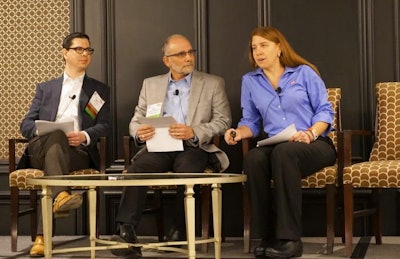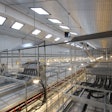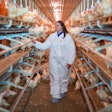
Broiler producers must work together and compromise in order to keep “slow growing” from becoming its “cage-free” movement.
While speaking at an event on the impact of animal welfare activism, Dr. Matt Salois, director of global scientific affairs and policy at Elanco Animal Health, and Dr. Kate Barger-Weathers, director of world animal welfare at Cobb-Vantress Inc., said the poultry industry has to work together, show resolution against unacceptable demands and rally around reasonable animal welfare practices.
Salois – who will also present at WATT Global Media’s Chicken Marketing Summit – and Barger-Weathers were joined by Dr. Ken Opengart, head of global animal health and welfare and U.S. sustainability at Keystone Foods, on a panel at the Animal Agriculture Alliance Stakeholders Summit to discuss the looming threat the slow-growing broiler movement and affiliated Global Animal Partnership (GAP) welfare standards present to the industry. The summit, focused on how animal agriculture can work collectively to push back against animal rights groups, took place May 3-4 in Kansas City, Missouri.
Cage-free versus slow-growing
While the movement picked up momentum in Europe and the specialty domestic egg market for years prior, cage-free egg production became almost ubiquitous in the U.S. egg industry largely due to activists' efforts. In 2015, McDonalds announced its plans to sell only eggs laid by cage-free hens in its restaurants in the U.S. and Canada by 2025. In the following months, hundreds of restaurants, grocers, hospitality organizations and caterers made similar pledges.
The industry responded by making its own commitments to produce cage-free eggs. Going cage-free, however, is not a simple or cheap task. Existing housing must be either renovated or replaced to make way for new cage-free housing systems. Cage-free hens consume more feed than caged hens and far more management is required to ensure success. After clearing those hurdles, farmers aren’t guaranteed they’ll sell their eggs at a profit. In May, Dolph Baker, CEO of Cal-Maine Foods Inc., said cage-free eggs are being overproduced and consumers aren’t currently willing to pay more for them. He also questioned if the pledges could be met.
The speakers said animal activist groups, through cage-free and other issues, discovered they could achieve quicker success pressuring corporations, rather than governments, to change. Activists leverage consumers’ emotions and notions of how a chicken should be raised to influence a retailer’s welfare policies. As Opengart said, activists are also willing to threaten serious public relations repercussions if their demands aren’t met.
With a successful campaign in cage-free eggs behind them, activists are now turning their attention to the much larger broiler chicken industry. Salois said the slow growing campaign benefits from the sheer magnitude of the 9 billion bird U.S. broiler flock and the consumer’s prior familiarity with the animal. Some retailers are already pledging only to sell slow-growing broiler meat. Opengart said the economic and environmental drawbacks of switching would be dire. He estimated broilers would be twice as expensive to raise and produce half as much meat.
Come together now or pay the price later
Barger-Weathers said the industry – including breeders, producers and retailers – needs to meet and establish a unified front to keep slow-growing movement from becoming the standard production practice. She said this will mean setting aside rivalries to form the best possible response.
“This is kind of a ship: Either everybody is going to have to sink, and everybody’s going to have to go that (slow-growing) route, or we can stay afloat and we can all work together,” she said. “So those conversations are starting to happen between competitors … we need to get in the same room and at least talk about this. Maybe we’re not going to agree on everything but we need to at least start talking about this because otherwise it’s going to be a big mess for everybody.”
Don’t cave, compromise
Salois said the industry should not immediately give in to activists’ demands simply to silence them.
“We’re put to this very reactive corner and so we want the problem to go away and, I think, what’s even worse is that you make a decision without fully understanding the impact of that decision across the animal welfare environment and economics,” he said.
However, the industry cannot just say no to activist demands and call it a day. Instead, Salois suggested taking a “no, but” approach.
“No to slow growing, but here’s what I am doing to improve animal welfare outcomes and I think then, some progress can be made,” Salois said.
The panelists said the industry would do well to find common standard on animal welfare and then rally around it. Farmers and breeders do care immensely about animal welfare, and the industry continues to improve its practices, but an industry-independent, science-based welfare standard would be ideal for proving the commitment to consumers and retailers.
Right now, Opengart said, the animal agriculture industry is not coming together and putting up a unified front against activist demands. If that trend continues, then the activists will continue to successfully pick off industries and brands one by one.
2017 Chicken Marketing Summit
The 2017 Chicken Marketing Summit is scheduled for July 16-18 at the Omni Grove Park Inn, Asheville, North Carolina. To learn more, go to www.WATTGlobalMedia.com/ChickenMarketingSummit.


















